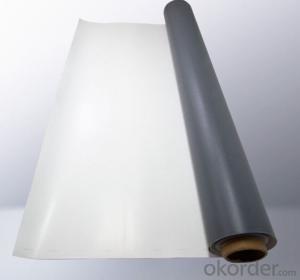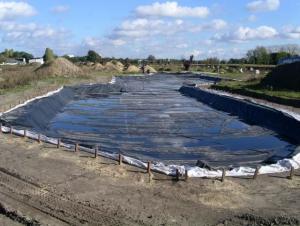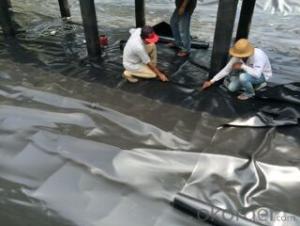EPDM Waterproof Membrane for Roof and Pond
- Loading Port:
- Qingdao
- Payment Terms:
- TT or LC
- Min Order Qty:
- 1000 m²
- Supply Capability:
- 100000 m²/month
OKorder Service Pledge
OKorder Financial Service
You Might Also Like
EPDM Coiled Rubber Waterproof Membrane for Ponds
EPDM Rubber Waterproof Membrane Description:
EPDM waterproof membrane is of high elasticity among high polymer waterproof materials and becomes a world-
popular waterproofing material. EPDM waterproof membrane is made from ternary ethylene-propylene
rubber, which is designed for waterproofing of exposed and non-exposed applications. EPDM waterproof
membrane production adopts the world-advanced equipment of cold feeding extrusion and continuous vulcanization
technology.
Main Features of EPDM Rubber Waterproof Membrane:
1. Excellent physical and mechanical performance
2 High tearing resistance
3 Good deformation adaptability
4 High puncture resistance
5 High aging resistance
6 High UV resistance
Specifications of EPDM Rubber Waterproof Membrane:
Material | EPDM Rubber |
Size | 1.2m (width)*20m (length) or customized, weldable type 2.05m or 4m width |
Thick | 1.2mm, 1.5mm, 2.0mm |
Type | Vulcanized & Weldable |
Pattern | Non-reinforced (homogeneous) |
Certificate | ISO9001/14001 |
Systems
Thanks to a variety of installation systems, the RubberGard EPDM Roofing System provides a solution for even the most challenging rooftops, for both renovation and new built applications.
Products
The RubberGard EPDM Roofing System consists of a high performing EPDM and a complete range of accessories. The combination proven technology offers a unique combination of features & benefits.Technical Information
CNBM Products provides to distributors, contractors, specifiers and building owners a comprehensive range of technical documents, such as specifications, data sheets, type approvals and detail drawings.Installation
It help the contractor installing the RubberGard EPDM Roofing System in accordance with requirements.Training
The RubberGard EPDM Roofing System is exclusively installed by approved roofing contractors that have successfully completed a training program in one of training centers.EPDM Project References
Operating since 3 decades in Europe and Asia, our Products has installed hundreds of thousands of EPDM roofs. The project portfolio includes a selection of major projects.
Images of EPDM Rubber Waterproof Membrane:
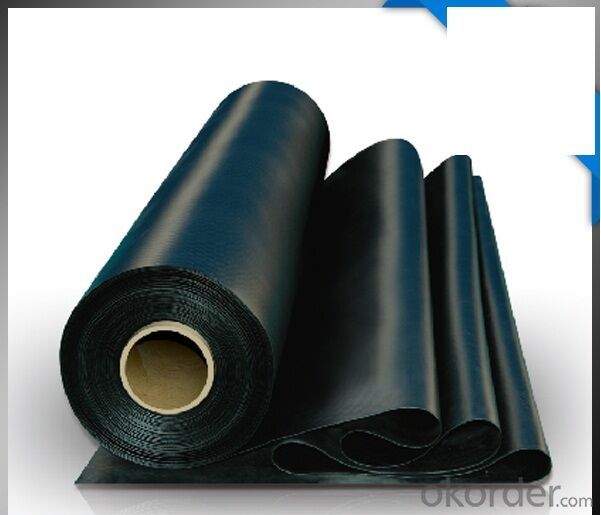
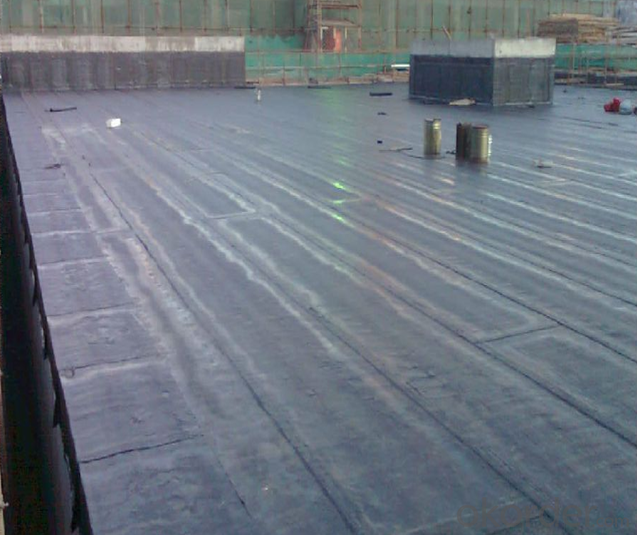
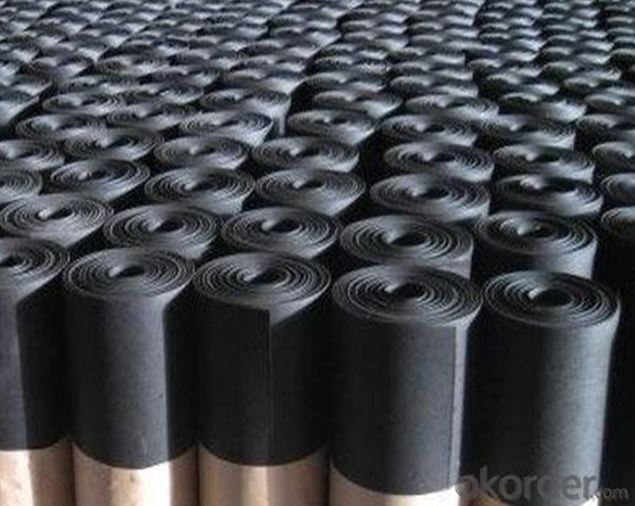
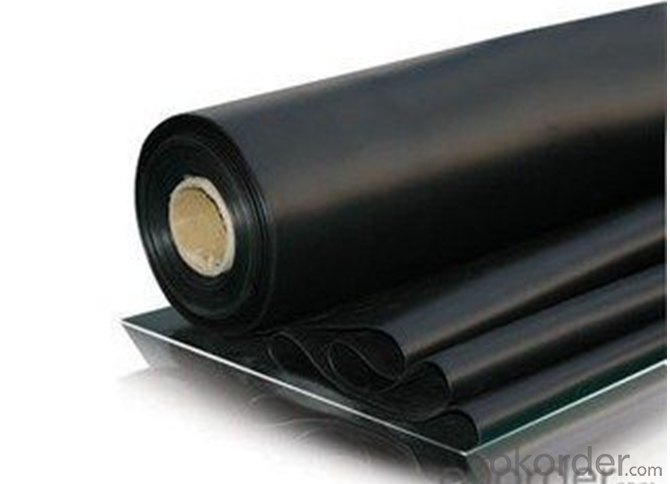
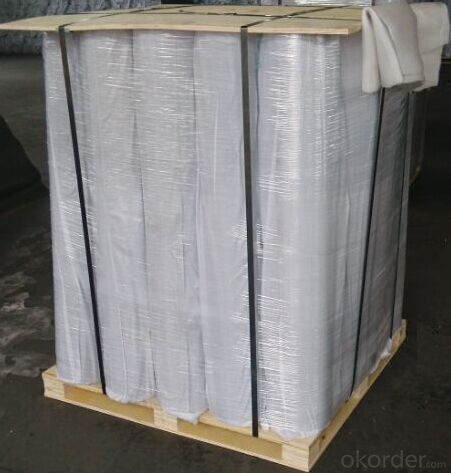
FAQ:
1. What are we supplying?
We are specialized in producing Colorful Asphalt Roof Shingle, SBS/APP modified bitumen waterproof membrane, Self adhesive bitumen
waterproof membrane, PVC waterproofing membrane, EPDM rubber roofing membrane, Single Component Polyurethane Waterproof
Coating, and Spray Polyurea Waterproof Coating
.
2. How Many years experience do we have?
We have been exported to more than 20 countries in the past 15 years.
3. How long do we usually reply your request?
We always reply our customer within 24 hours.
- Q:Can a waterproofing membrane be used on interior walls?
- Yes, a waterproofing membrane can be used on interior walls. Waterproofing membranes are designed to create a barrier against moisture, preventing water from penetrating the surface and causing damage. While they are commonly used on exterior walls to protect against rain and groundwater, they can also be used on interior walls in areas that are prone to moisture, such as bathrooms, kitchens, or basements. By applying a waterproofing membrane, you can effectively protect the interior walls from water damage, mold growth, and other moisture-related issues. It is important to note that the specific type of waterproofing membrane and the proper installation technique should be determined based on the specific needs and conditions of the interior walls. Consulting with a professional or following manufacturer guidelines is recommended to ensure proper application and long-lasting protection.
- Q:Can a waterproofing membrane be applied to vertical surfaces?
- Yes, a waterproofing membrane can be applied to vertical surfaces. In fact, waterproofing membranes are commonly used on vertical surfaces such as walls, foundations, and retaining walls to protect against water infiltration. These membranes are specifically designed to adhere to vertical surfaces and provide a protective barrier against water, preventing moisture from seeping into the structure. The application process typically involves cleaning and preparing the surface, applying a primer if necessary, and then installing the waterproofing membrane using a suitable adhesive or mechanical fastening system. This ensures that the membrane forms a continuous and secure seal, effectively preventing water penetration. Overall, waterproofing membranes offer an effective solution for waterproofing vertical surfaces and are widely used in construction and building maintenance projects.
- Q:Can a waterproofing membrane be used on both interior and exterior surfaces of a structure?
- Yes, a waterproofing membrane can be used on both interior and exterior surfaces of a structure. Waterproofing membranes are designed to create a barrier that prevents water or moisture from penetrating into the structure, whether it is applied on the inside or outside. On the interior, a waterproofing membrane can be used to protect basements, crawl spaces, or other areas prone to moisture intrusion. This helps to prevent water damage, mold growth, and other issues that can arise from excess moisture in these spaces. On the exterior, a waterproofing membrane is commonly used to protect the foundation, walls, and other structural elements from water infiltration. This is especially important in areas with heavy rainfall or where the water table is high. By applying a waterproofing membrane on the exterior, it helps to keep the structure dry and prevents potential damage caused by water seepage. It is important to note that different types of waterproofing membranes are available for specific applications, so the selection of the appropriate membrane will depend on the specific requirements of the project.
- Q:Does a waterproofing membrane require a protective layer?
- Yes, a waterproofing membrane typically requires a protective layer. The protective layer serves multiple purposes. Firstly, it helps to prevent damage to the waterproofing membrane during and after installation. It acts as a barrier against sharp objects, construction debris, and potential punctures. Additionally, the protective layer helps to distribute loads evenly and provide stability to the membrane, reducing the risk of damage caused by foot traffic or heavy equipment. Furthermore, the protective layer serves as a UV barrier, shielding the waterproofing membrane from the harmful effects of sunlight exposure. UV rays can degrade the membrane over time, leading to reduced effectiveness and potential leaks. The protective layer also helps to regulate temperature fluctuations, which can expand and contract the membrane, causing stress and compromising its waterproofing capabilities. In summary, a protective layer is essential for the longevity and performance of a waterproofing membrane. It safeguards against physical damage, UV radiation, and temperature fluctuations, ensuring the membrane's effectiveness in keeping water out and preserving the integrity of the structure it protects.
- Q:Can a waterproofing membrane be used on underground parking structures?
- Yes, a waterproofing membrane can be used on underground parking structures. In fact, it is highly recommended to have a waterproofing system in place to protect the structure from water ingress and potential damage. Underground parking structures are prone to water infiltration due to their below-ground level and close proximity to the water table. A waterproofing membrane acts as a barrier against water, preventing it from seeping into the structure and causing issues such as deterioration, corrosion, and mold growth. It helps to maintain the structural integrity of the parking facility and prolong its lifespan. Additionally, a properly installed waterproofing membrane can also provide protection against other sources of moisture, like rainwater runoff or groundwater. Overall, using a waterproofing membrane is a crucial step in ensuring the long-term durability and functionality of underground parking structures.
- Q:Is a waterproofing membrane resistant to saltwater or salt damage?
- Yes, a waterproofing membrane is typically resistant to saltwater or salt damage. Waterproofing membranes are designed to provide a barrier against water and moisture, and they are commonly used in various applications where exposure to saltwater or salt is expected, such as in marine environments or near coastal areas. These membranes are often made from materials that are specifically formulated to withstand the corrosive effects of saltwater or salt. Additionally, the installation of a waterproofing membrane includes proper preparation and sealing techniques to ensure its resistance to saltwater or salt damage. However, it is important to note that the specific resistance of a waterproofing membrane to saltwater or salt damage may vary depending on the type and quality of the membrane used. Therefore, it is recommended to consult with a professional or manufacturer to ensure the appropriate membrane is selected for the specific application and environment.
- Q:Are waterproofing membranes resistant to UV rays?
- Yes, waterproofing membranes are typically designed to be resistant to UV rays. They are formulated with additives and coatings that provide protection against the damaging effects of sunlight and ensure long-term durability and performance.
- Q:Can a waterproofing membrane be used on stainless steel surfaces?
- Indeed, stainless steel surfaces can benefit from the application of a waterproofing membrane. Stainless steel, a resilient and non-corrosive material widely utilized across different industries, is not impervious to water damage or corrosion, particularly in severe conditions. By applying a waterproofing membrane onto stainless steel surfaces, an extra shield against moisture is established, effectively warding off potential water damage, rusting, and corrosion. To guarantee optimal adhesion and durable protection, it is crucial to ensure the compatibility of the waterproofing membrane with stainless steel and its correct application.
- Q:Can a waterproofing membrane be used on terraces or patios?
- Yes, a waterproofing membrane can be used on terraces or patios. In fact, it is highly recommended to use a waterproofing membrane in these areas to prevent water damage and leakage. Terraces and patios are exposed to various weather conditions, including rain and snow, which can lead to moisture seeping into the underlying structure. A waterproofing membrane acts as a barrier, preventing water from penetrating the surface and protecting the integrity of the terrace or patio. It helps to extend the lifespan of the structure and prevents costly repairs in the long run. Additionally, using a waterproofing membrane also helps to create a more comfortable and usable space, as it eliminates the risk of water accumulation and potential slip hazards. Overall, investing in a high-quality waterproofing membrane is a wise decision for anyone looking to protect their terrace or patio from water damage.
- Q:Can a waterproofing membrane be used for a green roof?
- Yes, a waterproofing membrane can be used for a green roof. A waterproofing membrane is an essential component of any green roof system as it helps to protect the underlying structure from water damage. It prevents water infiltration, which can cause structural damage and mold growth. Additionally, a waterproofing membrane helps to retain the necessary moisture within the green roof system, ensuring the plants have a consistent water supply. By using a waterproofing membrane, you can effectively create a sustainable and environmentally friendly green roof while also maintaining the integrity of the building structure.
1. Manufacturer Overview |
|
|---|---|
| Location | |
| Year Established | |
| Annual Output Value | |
| Main Markets | |
| Company Certifications | |
2. Manufacturer Certificates |
|
|---|---|
| a) Certification Name | |
| Range | |
| Reference | |
| Validity Period | |
3. Manufacturer Capability |
|
|---|---|
| a)Trade Capacity | |
| Nearest Port | |
| Export Percentage | |
| No.of Employees in Trade Department | |
| Language Spoken: | |
| b)Factory Information | |
| Factory Size: | |
| No. of Production Lines | |
| Contract Manufacturing | |
| Product Price Range | |
Send your message to us
EPDM Waterproof Membrane for Roof and Pond
- Loading Port:
- Qingdao
- Payment Terms:
- TT or LC
- Min Order Qty:
- 1000 m²
- Supply Capability:
- 100000 m²/month
OKorder Service Pledge
OKorder Financial Service
Similar products
New products
Hot products
Hot Searches
Related keywords


